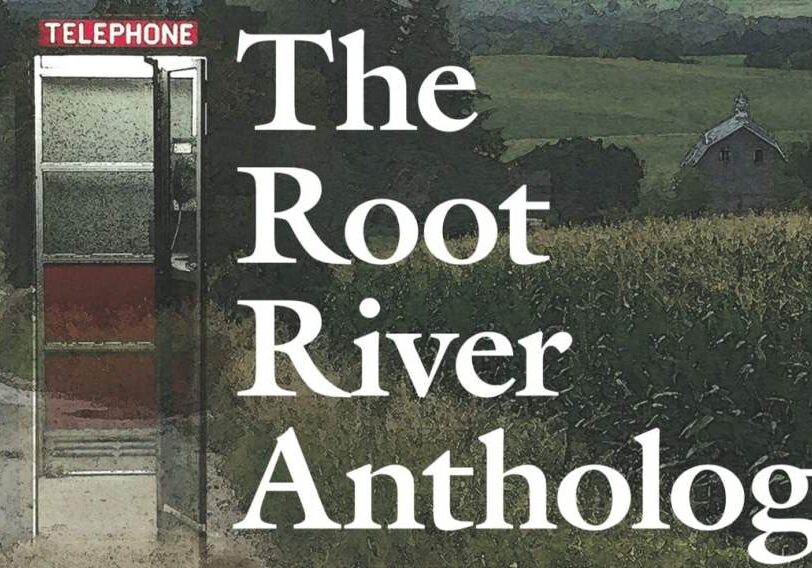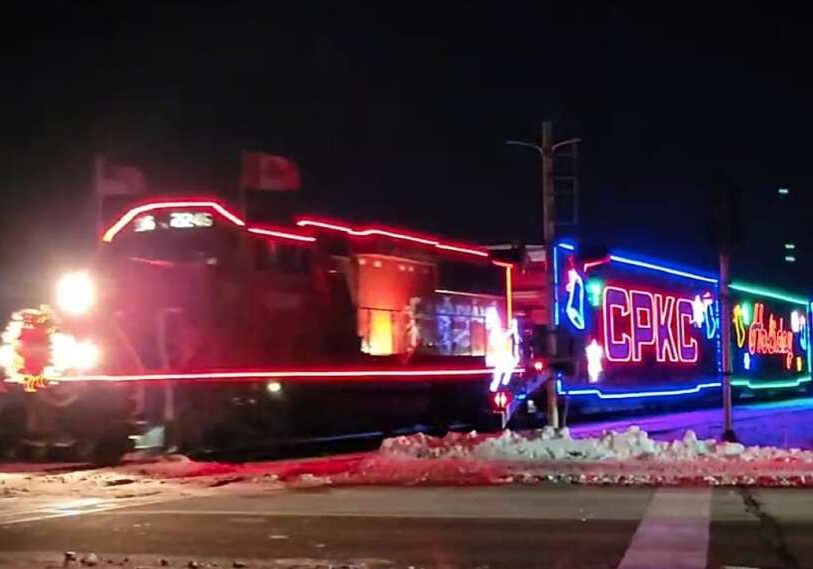Profile | In Conversation with Stained Glass Artist Karl Unnasch

PILOT MOUND — Karl Unnasch grew up on a farm near Pilot Mound, Minnesota, today a curve-in-the road rural town about 10 miles east of Chatfield where he still has his studio. Karl and his wife, Nicole, and their young son, Hugo, split their time between Pilot Mound and a second home in La Crosse, Wisconsin. His award-winning public pieces, featuring metal sculptures, stained glass, and more, have been delighting people for the last three decades, in theaters, libraries, businesses, museums, public spaces, and on college campuses.
Arguably his best-known local work is his design of the Commonweal Theater lobby in Lanesboro, but Unnasch enjoys a national reputation. (He’s exhibited pieces in Canada and London as well). Three of his works were recently highlighted in Experience Art textbooks produced by the respected Davis Publications, Inc.
I recently visited with him in his Pilot Mound studio for a wide-ranging conversation about art, life, and good advice on both.

Unnasch’s “Rustician,” a reclaimed 1930s McCormick tractor featuring backlit stained glass, was recently honored with mention in the Davis Publications school art textbook. (Photo submitted by Karl Unnasch)
Bluff Country is the friendly side of nature
According to Karl, “The area we live in inspires art and artists. It’s exemplary of the driftless region. I love living here. No matter where I travel or where I’ve lived, my heart has always been in this area.
“I grow even fonder of it over time—its landscape, innate beauty, and uniqueness. It offers what I like to think of as the friendly side of nature. Not too tall, not too flat, so far it’s not too hot. It’s not too cold, either, because growing up here you learn to manage that. There’s a reason why we’re a quilt culture! There’s also a reason why we like to stick our feet in creeks.
“We have everything we need plus the extras necessary for a good life. Now we’ll see if we can hang on to it.”

“Bloodroot” a 25-foot tall stained glass sculpture was installed at the Royal Botanical Gardens in Burlington, Ontario, Canada, in 2016. (Photo submitted by Karl Unnasch)

The moon rises behind the petals of the “Bloodroot” sculpture. (Photo submitted by Karl Unnasch)
Teaching versus doing art
“I studied and taught art at the undergrad and grad level before I stopped teaching and committed to be a full-time artist. That presented its own set of challenges, but I’m more geared towards that. I like controlling my own schedule and having my own autonomy. It’s worked out well.
“Some of the trappings and window dressing of larger scale artistic success are nice, but I also like the southeast Minnesota lifestyle. I like sitting on my porch and having a bourbon. I like calling up a friend to ask, ‘do you want to go fishing?’ I don’t want to lose that.”
A log cabin named “Slumgullion”
“Years ago, on a fishing trip in northern Wisconsin I came across Gene’s Antiques, a very eclectic junk shop that had a rare, two-room, 19th-century log cabin for sale. I bought it. I often use reclaimed objects in my art; this became the largest reclaimed object piece I’d ever done.

Unnasch’s “Slumgullion” is a reclaimed 19th-century log cabin utilizing stained glass, resin-bonded textiles and more. (Photo submitted by Karl Unnasch)
“The roof of the cabin (known as ‘Slumgullion’) is a series of colored t-shirts dipped in resin and assembled as shingles. Natural light comes through and makes it look like you’re standing underneath a big quilt. For me this iconic log cabin epitomizes a direct line to the rural American experience.
“I worked on it for a year. When I finished, I knew that if I didn’t do any more art after that, it would be okay. It’s now permanently installed at the Philbrook Museum of Art in Tulsa, Oklahoma, where it’s used for small concerts and educational programs.”

The interior of “Slumgullion” now on permanent display at the Philbrook Museum of Art in Tulsa, Oklahoma. (Photo submitted by Karl Unnasch)
Stained Glass is series of frozen brush strokes
“Stained glass allures me. I still spend about a third of my time in that medium. It’s a series of frozen brush strokes that never fades, a collage of colors that – despite nature’s best efforts – never changes. The chemistry of glass makes that happen, that makes it a touchstone image of beauty.
“I call stained glass a ‘sneaky’ medium, because while people think it’s fragile and delicate, it really isn’t. It’s tough stuff! There’s a reason they put it in windows. It doesn’t react well to bullets, bb’s and rocks, of course, but neither does flat glass. When built right, stained glass can handle the elements.

Karl Unnasch’s creation of “Operant (An Oldowonk Cataract)” depicts an enhanced red dump truck as a tribute to laborers. This piece was displayed in Boston’s Rose Kennedy Greenway in 2019. (Photo submitted by Karl Unnasch)
“Stained glass is permanent, but it also changes depending on the light sources that touch it. Notice that ‘sources’ is plural. Light comes through the glass and filters it. (How many paintings allow that to happen?) Degrees of light also bounce off the glass. There’s an interplay in all that. Depending on the time of day and who’s watching it, all that changes. Look at stained glass when a storm-cloud moves behind it. None of that is by accident. It’s why churches in Europe were filled with this stuff. Stained glass has a poetic nature, it was designed to enrapture people, and it does.”

An iconic farm tractor with stained glass images created by Karl Unnasch for the 2010 Minnesota Biennial. (Photo submitted by Karl Unnasch)
Working in ‘dozer’ mode
“I’m goal oriented. I find joy in getting work done. I can go into ‘dozer’ (for bulldozer) mode and just focus on that work. That’s when I’m at my best creative flow. It means locking doors, no interruptions, putting on whatever sound I need to enhance the experience. It’s a Zen, being-in-the-moment thing. I don’t do it out of a desperation but out of the pure drive of it. That’s not everyone’s cup of tea, not everyone embraces ‘dozer’ mode, but it works for me. After the work is done, then I put my feet up.”

Karl Unnasch has a home and studio in Pilot Mound, Minnesota. (Photo submitted by Karl Unnasch)
Advice to a young Karl Unnasch
“Shut up and listen! More listening, Less talk. Be receptive. Realize you don’t know everything. That you don’t know much at all, actually. Always be receptive to learning more.”
Advice for a young artist today
“Good guidance fosters good art. Look for a good mentor, someone who has your best interest at heart. Find someone you trust. Do whatever you can to get under their wing.
“Agree on what you need and are looking for. If it’s not working for you, make a change. Find someone else.
“Trust your heart.
“Know that this isn’t easy. Only 2% of undergrads studying art go on to study it in grad school; only 2% of them will actually pursue art full-time.
“I’ve been able to do that and I feel great about it. I enjoy being an artist. It’s been a helluva ride, and it ain’t over yet!”

Root River Current’s coverage of the arts is made possible, in part, by the voters of Minnesota through a grant from the Southeastern Minnesota Arts Council thanks to a legislative appropriation from the arts & cultural heritage fund.






